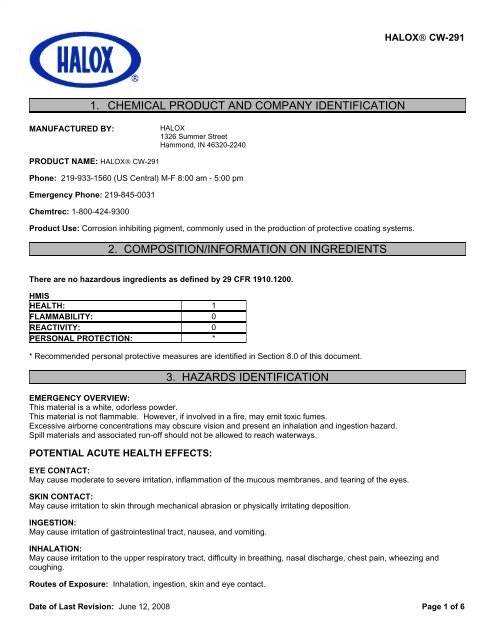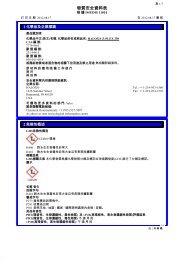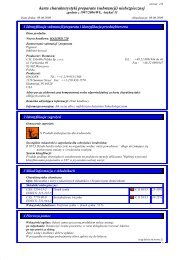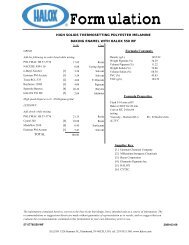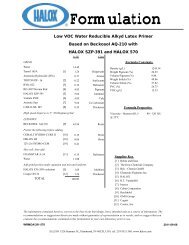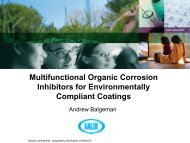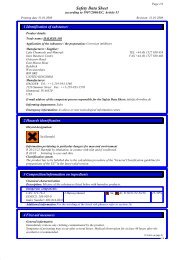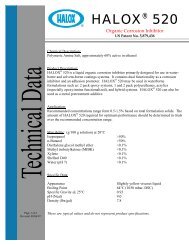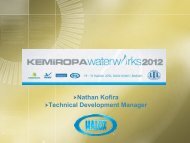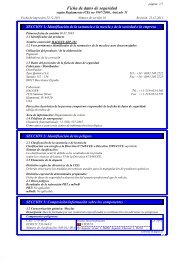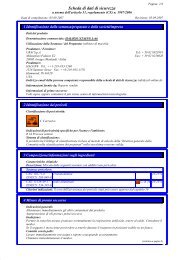1. chemical product and company identification 2 ... - Halox
1. chemical product and company identification 2 ... - Halox
1. chemical product and company identification 2 ... - Halox
Create successful ePaper yourself
Turn your PDF publications into a flip-book with our unique Google optimized e-Paper software.
HALOX® CW-291<br />
<strong>1.</strong> CHEMICAL PRODUCT AND COMPANY IDENTIFICATION<br />
MANUFACTURED BY:<br />
HALOX<br />
1326 Summer Street<br />
Hammond, IN 46320-2240<br />
PRODUCT NAME: HALOX® CW-291<br />
Phone: 219-933-1560 (US Central) M-F 8:00 am - 5:00 pm<br />
Emergency Phone: 219-845-0031<br />
Chemtrec: 1-800-424-9300<br />
Product Use: Corrosion inhibiting pigment, commonly used in the <strong>product</strong>ion of protective coating systems.<br />
2. COMPOSITION/INFORMATION ON INGREDIENTS<br />
There are no hazardous ingredients as defined by 29 CFR 1910.1200.<br />
HMIS<br />
HEALTH:<br />
1<br />
FLAMMABILITY: 0<br />
REACTIVITY: 0<br />
PERSONAL PROTECTION: *<br />
* Recommended personal protective measures are identified in Section 8.0 of this document.<br />
3. HAZARDS IDENTIFICATION<br />
EMERGENCY OVERVIEW:<br />
This material is a white, odorless powder.<br />
This material is not flammable. However, if involved in a fire, may emit toxic fumes.<br />
Excessive airborne concentrations may obscure vision <strong>and</strong> present an inhalation <strong>and</strong> ingestion hazard.<br />
Spill materials <strong>and</strong> associated run-off should not be allowed to reach waterways.<br />
POTENTIAL ACUTE HEALTH EFFECTS:<br />
EYE CONTACT:<br />
May cause moderate to severe irritation, inflammation of the mucous membranes, <strong>and</strong> tearing of the eyes.<br />
SKIN CONTACT:<br />
May cause irritation to skin through mechanical abrasion or physically irritating deposition.<br />
INGESTION:<br />
May cause irritation of gastrointestinal tract, nausea, <strong>and</strong> vomiting.<br />
INHALATION:<br />
May cause irritation to the upper respiratory tract, difficulty in breathing, nasal discharge, chest pain, wheezing <strong>and</strong><br />
coughing.<br />
Routes of Exposure: Inhalation, ingestion, skin <strong>and</strong> eye contact.<br />
Date of Last Revision: June 12, 2008 Page 1 of 6
HALOX® CW-291<br />
POTENTIAL CHRONIC HEALTH EFFECTS:<br />
Chronic exposures are considered negligible.<br />
Medical conditions aggravated by exposure: Any pre-existing lung or pulmonary condition.<br />
4. FIRST AID MEASURES<br />
INHALATION:<br />
Remove victim to fresh air. Restore breathing if necessary (AR, CPR). Seek medical attention if symptoms develop or<br />
persist.<br />
INGESTION:<br />
If victim is alert, wash out mouth with water. Seek medical attention if symptoms develop or persist.<br />
EYES:<br />
Do not let victim rub eyes. Flush eyes well with water for at least 15 minutes. If irritation persists, seek medical attention.<br />
SKIN:<br />
Wash exposed area with soap <strong>and</strong> water. If irritation persists, seek medical attention.<br />
FLASH POINT (° F) Not applicable.<br />
OSHA FLAMMABILITY CLASSIFICATION: Not Applicable.<br />
5. FIRE FIGHTING MEASURES<br />
EXTINGUISHING MEDIA: This material is not flammable <strong>and</strong> will not react with commercially available extinguishing<br />
media. Use appropriate media for surrounding fire.<br />
SPECIAL FIREFIGHTING PROCEDURES: Firefighters should wear a positive-pressure self-contained breathing<br />
apparatus (SCBA) <strong>and</strong> protective fire fighting clothing.<br />
AUTOIGNITION TEMP (° F) Unknown<br />
UNUSUAL FIRE AND EXPLOSION HAZARDS: None.<br />
6. ACCIDENTAL RELEASE MEASURES<br />
ACTION TO BE TAKEN IF MATERIAL IS RELEASED OR SPILLED:<br />
Always wear recommended personal protective equipment. Limit foot <strong>and</strong> vehicular traffic to minimize mechanical<br />
agitation <strong>and</strong> dispersion. The spill should first be contained <strong>and</strong> the area should be cleaned by wet-sweeping or vacuum<br />
cleaning (HEPA filter). Notify In-plant Spill Response Coordinator or appropriate party to determine any additional<br />
requirements pertaining to spill response.<br />
CONTAINMENT TECHNIQUES: This is a solid material <strong>and</strong> will not travel far from the spill location unless mechanically<br />
agitated. Therefore, no specific containment techniques are recommended outside of restricting access to the spill<br />
location.<br />
SPILL RESPONSE EQUIPMENT:<br />
• Vacuum, equipped with HEPA filter<br />
• Dustpan, shovel or scoop<br />
• Broom, wet mop<br />
• Bags, drums or sacks for collection<br />
Date of Last Revision: June 12, 2008<br />
Page 2 of 6
HALOX® CW-291<br />
SPILL RESPONSE PERSONAL PROTECTIVE EQUIPMENT:<br />
• Rubber or leather gloves<br />
• Cotton overalls<br />
• Chemical/safety impact goggles<br />
• If airborne concentrations cannot be controlled below the required or recommended exposure limits, respiratory<br />
equipment, as per Section 8.0, may be required.<br />
7. HANDLING AND STORAGE<br />
HANDLING:<br />
Always wear recommended personal protective equipment. Avoid dust generation.<br />
STORAGE:<br />
Store in a cool, dry, well-ventilated area away from sources of ignition. Keep containers tightly closed when not in use.<br />
Use care when h<strong>and</strong>ling <strong>and</strong> storing containers to prevent damage.<br />
8. EXPOSURE CONTROLS/PERSONAL PROTECTION<br />
ENGINEERING CONTROLS: General mechanical ventilation is acceptable, as long as concentrations are maintained<br />
below required/recommended limits. Where acceptable concentrations cannot be maintained by general mechanical<br />
ventilation, local exhaust ventilation is recommended.<br />
RESPIRATORY PROTECTION EQUIPMENT: NIOSH/MSHA approved respiratory protection is recommended for use in<br />
airborne concentrations exceeding exposure limits identified in section 2. Where no required/recommended exposure<br />
limits exist, personal protection measures should be incorporated when potential airborne concentrations may exceed 10<br />
mg/m^3 total dust <strong>and</strong> 3 mg/m^3 respirable dust (particulate containing no asbestos <strong>and</strong>
HALOX® CW-291<br />
Evaporation Rate<br />
(Butyl Acetate=1)<br />
Not applicable<br />
pH* 10.1<br />
Mean Particle Size (µm) 5.5-5.8<br />
Specific Gravity (water=1) 2.6-2.7<br />
*at 10% slurry by weight in water.<br />
STABILITY: Stable.<br />
HAZARDOUS POLYMERIZATION: Will not occur.<br />
10. STABILITY AND REACTIVITY<br />
HAZARDOUS THERMAL DECOMPOSITION/COMBUSTION PRODUCTS: After prolonged contact with water, this<br />
substance will revert to its associated salts.<br />
INCOMPATIBILITY (MATERIALS TO AVOID): This <strong>product</strong> will solubilize in acid, ammonia hydroxide, or prolonged<br />
contact with water.<br />
CONDITIONS TO AVOID: Incompatible materials, excess heat.<br />
1<strong>1.</strong> TOXICOLOGICAL INFORMATION<br />
TOXICITY DATA: This <strong>product</strong> contains wollastonite. Wollastonite is listed by IARC as a Group 3<br />
carcinogen. Therefore, there is inadequate evidence of its carcinogenicity in humans<br />
<strong>and</strong> inadequate or limited evidence in experimental animals.<br />
ACUTE ORAL LD50 (mg/kg):<br />
ACUTE INHALATION LC50:<br />
ACUTE DERMAL LD50 (mg/kg):<br />
>5,000 (RABBIT)<br />
No data at this time.<br />
>2,000 (RABBIT)<br />
ACUTE EYE EXPOSURE: Maximum Draize Score Average: 8-12 (positive), as defined by 16 CFR 1500.42.<br />
12. ECOLOGICAL INFORMATION<br />
ECOTOXICOLOGICAL INFORMATION: No data at this time<br />
CHEMICAL FATE INFORMATION: No data at this time.<br />
13. DISPOSAL CONSIDERATIONS<br />
DISPOSAL METHOD: Re-blend spilled, unused, off-specification materials with other materials, where possible, in<br />
support of waste minimization. Where this is not possible, dispose of material according to Federal (country-specific),<br />
state, <strong>and</strong> local requirements.<br />
EMPTY CONTAINERS: This <strong>product</strong> may be shipped in paper or nylon bags, steel drums, plastic or steel pails, or<br />
intermediate bulk containers. All residual material should be emptied <strong>and</strong> the containers recycled where possible. Where<br />
recycling is not possible, all containers should be disposed of in accordance with Federal (country-specific), state, <strong>and</strong><br />
local requirements.<br />
Date of Last Revision: June 12, 2008<br />
Page 4 of 6
HALOX® CW-291<br />
14. TRANSPORT INFORMATION<br />
DOT SHIPPING NAME:<br />
Not Regulated<br />
AIR FREIGHT<br />
TRANSPORTATION:<br />
Not Regulated<br />
OCEAN TRANSPORTATION:<br />
Not Regulated<br />
15. REGULATORY INFORMATION<br />
TSCA STATUS:<br />
All components of this <strong>product</strong> are on the US TSCA Inventory.<br />
CALIFORNIA PROPOSITION 65:<br />
This <strong>product</strong> is not known to contain any <strong>chemical</strong>s known to the state of California to cause cancer or birth defects.<br />
However, we do not conduct routine analysis for all listed materials.<br />
SARA 302 EXTREMELY HAZARDOUS SUBSTANCES LIST:<br />
This <strong>product</strong> does not contain greater than <strong>1.</strong>0% of any <strong>chemical</strong> substance on the SARA Extremely Hazardous<br />
Substance List.<br />
SARA (311, 312) HAZARD CLASS:<br />
None<br />
SARA SECTION 313 TOXIC CHEMICALS:<br />
None<br />
CANADIAN INVENTORY:<br />
All components are on the Domestic Substance List (DSL).<br />
EINECS REGULATIONS:<br />
All components are on the European Inventory of Existing Commercial Chemical Substances (EINECS).<br />
16. OTHER INFORMATION<br />
DISCLAIMER OF EXPRESSED AND IMPLIED WARRANTIES:<br />
The information in this document is believed to be correct as of the date issued. However, no warranty of merchantability,<br />
fitness for any particular purpose, or any other warranty is expressed or is to be implied regarding the accuracy or<br />
completeness of this information, the results to be obtained from the use of this information or the <strong>product</strong>, the safety of<br />
this <strong>product</strong>, or the hazards related to its use. This information <strong>and</strong> <strong>product</strong> are furnished on the condition that the person<br />
receiving them shall make his own determination as to the suitability of the <strong>product</strong> for his particular purpose <strong>and</strong> on the<br />
condition that he assume the risk of his use thereof.<br />
17. LABEL INFORMATION<br />
SIGNAL WORD:<br />
TARGET ORGANS:<br />
EYES:<br />
SKIN:<br />
NOTICE<br />
May cause eye, skin, or respiratory irritation.<br />
Do not let victim rub eyes. Flush eyes well with water for at least 15 minutes. If<br />
irritation persists, seek medical attention.<br />
Wash exposed area with soap <strong>and</strong> water. If irritation persists, seek medical attention.<br />
Date of Last Revision: June 12, 2008<br />
Page 5 of 6
HALOX® CW-291<br />
INGESTION:<br />
INHALATION:<br />
HANDLING:<br />
STORAGE:<br />
IN CASE OF SPILL:<br />
EXTINGUISHING MEDIA:<br />
CALIFORNIA PROPOSITION 65:<br />
If victim is alert, wash out mouth with water. Seek medical attention if symptoms<br />
develop or persist.<br />
Remove victim to fresh air. Restore breathing if necessary (AR, CPR). Seek medical<br />
attention if symptoms develop or persist.<br />
Always wear recommended personal protective equipment. Avoid contact with skin,<br />
eyes <strong>and</strong> clothing.<br />
Store in a cool, dry, well-ventilated area away from sources of ignition. Keep<br />
containers tightly closed when not in use. Use care when h<strong>and</strong>ling <strong>and</strong> storing<br />
containers to prevent damage.<br />
Collect <strong>and</strong> dispose in accordance with federal, state <strong>and</strong> local regulations.<br />
This material is not flammable <strong>and</strong> will not react with commercially available<br />
extinguishing media. Use appropriate media for surrounding fire.<br />
This <strong>product</strong> is not known to contain any <strong>chemical</strong>s known to the state of California to<br />
cause cancer or birth defects. However, we do not conduct routine analysis for all<br />
listed materials.<br />
Date of Last Revision: June 12, 2008<br />
Page 6 of 6


